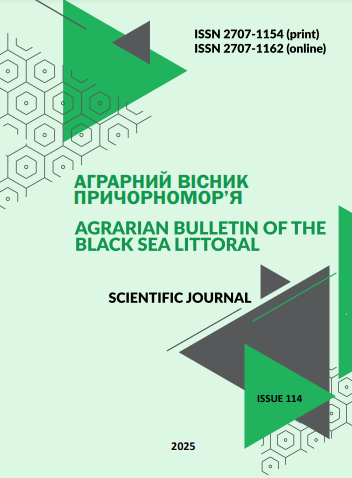INNOVATIONS IN SANITATION AND HYGIENE IN CATTLE BREEDING
DOI:
https://doi.org/10.37000/abbsl.2025.114.05Keywords:
disinfection, method, preparation, concentration, exposure.Abstract
The article presents the results of determining effective regimens and developing methods for the use of three disinfectants, which, in various combinations, include quaternary ammonium compounds, polyhexamethylene guanidine hydrochloride, glutaraldehyde, and other substances. The research was conducted at the production facilities of the National Scientific Center "Institute of Experimental and Clinical Veterinary Medicine" (Kharkiv). The disinfectants were applied according to current guidelines and regulations. The proposed disinfection methods align with modern biosafety and biosecurity requirements in livestock production. They are user-friendly, environmentally safe, highly effective, and cost-efficient. The findings from this research provide valuable resources for planning and implementing sanitary and hygienic measures in livestock production. Future research aims to develop a comprehensive, science-based system of sanitary and hygienic practices specifically tailored for dairy farming.
References
Ahmed, W.I., Mohammed, A.N., & Sleim, AS.A. (2024). Efficacy evaluation of hydrogen peroxide disinfectant based zinc oxide nanoparticles against diarrhea causing Escherichia coli in ruminant animals and broiler chickens. Scientific Reports, 14, 9159 (2024). https://doi.org/10.1038/s41598-024-59280-4
Alarcon, P., Marco-Jimenez, F., Horigan, V., Ortiz-Pelaez, A., Rajanayagam, B., Dryden, A., Simmons, H., Konold, T., Marco, C., Charnley, J., Spiropoulos, J., Cassar, C., & Adkin, A. (2021). A review of cleaning and disinfection guidelines and recommendations following an outbreak of classical scrapie. Preventive Veterinary Medicine, 193, 105388. https://doi.org/10.1016/j.prevetmed.2021.105388
Aliiev, E., Paliy, A., Kis, V., Paliy, A., Petrov, R., Plyuta, L., Chekan, O., Musiienko, O., Ukhovskyi, V., & Korniienko, L. (2022). Establishment of the influence of technical and technological parameters of dairy and milking equipment on the efficiency of machining. Eastern-European Journal of Enterprise Technologies, 1(1(115)), 44–55. https://doi.org/ 10.15587/1729-4061.2022.251172
Allen, R., Boden, L.A., Hutchinson, I., Stirling, J., & Porphyre, T. (2024). Cleaning practices of transport vehicles by commercial and non-commercial livestock markets users in Scotland. Research in Veterinary Science, 180, 105413. https://doi.org/10.1016/j.rvsc.2024.105413
Hancox, L.R., Le Bon, M., Dodd, C.E., & Mellits, K.H. (2013). Inclusion of detergent in a cleaning regime and effect on microbial load in livestock housing. The Veterinary Record, 173(7), 167. https://doi.org/10.1136/vr.101392
Hasan, M.A., Miyaoka, Y., Kabir, M.H., Kadota, C., Hakim, H., Shoham, D., Murakami, H., & Takehara, K. (2022). Evaluation of virucidal quantitative carrier test towards bovine viruses for surface disinfectants while simulating practical usage on livestock farms. Microorganisms, 10(7), 1320. https://doi.org/10.3390/microorganisms10071320
Jiang, L., Li, M., Tang, J., Zhao, X., Zhang, J., Zhu, H., Yu, X., Li, Y., Feng, T., & Zhang, X. (2018). Effect of different disinfectants on bacterial aerosol diversity in poultry houses. Frontiers in Microbiology, 9, 2113. https://doi.org/10.3389/fmicb.2018.02113
Kamal, M.A., Khalaf, M.A., Ahmed, Z.A.M., & Jakee, J.E. (2019). Evaluation of the efficacy of commonly used disinfectants against isolated chlorine-resistant strains from drinking water used in Egyptian cattle farms. Veterinary World Journal, 12(12), 2025–2035. https://doi.org/10.14202/vetworld.2019.2025-2035
Kim, S., Chung, H., Lee, H., Myung, D., Choi, K., Kim, S., Htet, S.L., Jeong, W., & Choe, N. (2020). Evaluation of the disinfectant concentration used on livestock facilities in Korea during dual outbreak of foot and mouth disease and high pathogenic avian influenza. Journal of Veterinary Science, 21(3), e34. https://doi.org/10.4142/jvs.2020.21.e34
Maertens, H., Van Coillie, E., Millet, S. Van Weyenberg, S., Sleeckx, N., Meyer, E., Zoons, J., Dewulf, J., & De Reu, K. (2020). Repeated disinfectant use in broiler houses and pig nursery units does not affect disinfectant and antibiotic susceptibility in Escherichia coli field isolates. BMC Veterinary Research, 16, 140 (2020). https://doi.org/10.1186/s12917-020-02342-2
Matsuzaki, S., Azuma, K., Lin, X., Kuragano, M., Uwai, K., Yamanaka, S., & Tokuraku, K. (2021). Farm use of calcium hydroxide as an effective barrier against pathogens. Scientific Reports, 11(1), 7941. https://doi.org/10.1038/s41598-021-86796-w
Onodera, T., Sakudo, A., Sugiura, K., Haritani, M., Furusaki, K., & Kirisawa, R. (2023). Antiviral agents and disinfectants for foot-and-mouth disease (Review). Biomedical Reports, 19, 57. https://doi.org/10.3892/br.2023.1639
Paliy, A., Pavlichenko, O., Berezovskyi, A., Fotin, A., Kisil, D., & Panasenko, O. (2024). Bactericidal properties of inorganic acids against mycobacteria. Veterinarska Stanica, 55 (4), 375–386. https://doi.org/10.46419/vs.55.4.8
Paliy, A.P. (2018). Differential sensitivity of mycobacterium to chlorine disinfectants. Mikrobiolohichnyi Zhurnal, 80(2), 104–116.
https://doi.org/10.15407/microbiolj80.02.104
Rodionova, K., Paliy, A., & Кhimych, M. (2021). Veterinary and sanitary assessment and disinfection of refrigerator chambers of meat processing enterprises. Potravinarstvo Slovak Journal of Food Sciences, 15, 616–626. https://doi.org/10.5219/1628
Tarka, P., & Nitsch-Osuch, A. (2021). Evaluating the virucidal activity of disinfectants according to European Union standards. Viruses, 13(4), 534. https://doi.org/10.3390/v13040534
Weber, L., & Meemken, D. (2018). Hygienic measures during animal transport to abattoirs - a status quo analysis of the current cleaning and disinfection of animal transporters in Germany. Porcine Health Management, 4, 1. https://doi.org/10.1186/s40813-017-0078-x
Yakubchak, O.M., Khomenko, V.I., Midyk, S.V., Adamenko, L.V., Oliynyk, L.V., Yashchenko, O.F., Kovalenko, V.L., Sergienko, O.I., Kovalchyk, L.M., & Khom’yak, R.V. (2010). Veterinary disinfection, deodorization, disinsection, disinvasion, deratization. Instructions. – K.: Bioprom, 62 p.
Yu, D., Stothard, P., & Neumann, N.F. (2024). Emergence of potentially disinfection-resistant, naturalized Escherichia coli populations across food- and water-associated engineered environments. Scientific Reports, 14, 13478 (2024). https://doi.org/10.1038/s41598-024-64241-y
Zavgorodnii, A.I., Pozmogova, S.A., Kalashnyk, M.V., Paliy, A.P., Plyuta, L.V., & Palii, A.P. (2021). Etiological factors in triggering non-specific allergic reactions to tuberculin in cattle. Regulatory Mechanisms in Biosystems, 12(2), 228–233. https://doi.org/10.15421/022131
Zavhorodnii, A., Bilushko, V., Paliy, A., Kalashnyk, M., Kalashnyk, N., & Paliy, A. (2022). Freeze-Drying improved the stability of Tuberculin Purified Protein Derivative (PPD) in mammals. Problems of Cryobiology and Cryomedicine, 32(1), 63–67. https://doi.org/10.15407/cryo32.01.063
Downloads
Published
How to Cite
Issue
Section
License

This work is licensed under a Creative Commons Attribution-NonCommercial 4.0 International License.


